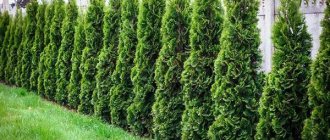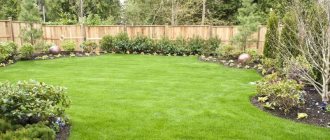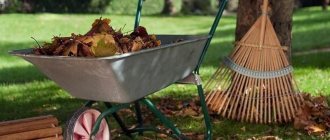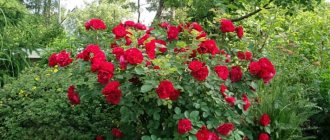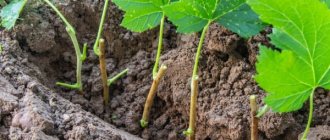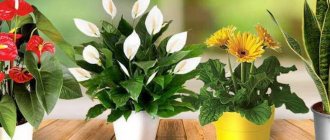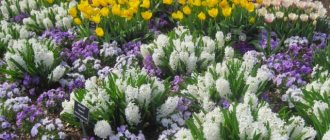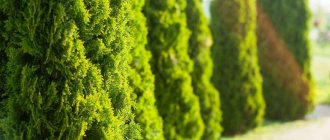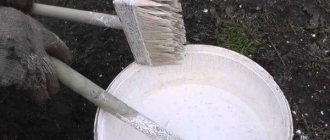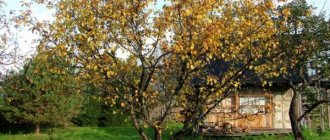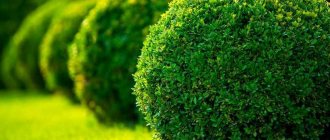Brugmansia is a beautiful flowering ornamental plant of the Solanaceae family. The culture is thermophilic, so it can winter in open ground only in the southern regions. In all other areas, the plant must be dug up. Planting and caring for Brugmansia in the open ground requires adherence to certain rules; only if they are followed will the crop fully develop and bloom profusely every year.
The shoots of Brugmansia are initially flexible, but by the end of the season they become lignified
General description of Brugmansia
The flower is a small tree, the height of which reaches 1.5-4.0 m. In spring and throughout the summer, the plant actively grows shoots.
Important! To obtain a beautiful crown shape, it is recommended to regularly remove shoots that stand out from the general mass.
The leaf blades are oval-elongated, large. Their length reaches 20-25 cm and width 10-15 cm. They are attached to the shoots using petioles. The surface of the plates is slightly pubescent.
The plant forms a branched root system. Initially, the shoots grow in the upper layer of the soil, and then deepen significantly.
The main decoration of Brugmansia is its tubular flowers, which exude a pleasant aroma. The length is about 20-25 cm, the diameter of the corolla during opening is 15 cm. They hang on the plant and form a kind of waterfall. Color of flowers in delicate tones. It can be white, pink, yellow. Some species have a shade with transitions - from the base to the corolla.
The aroma of flowers intensifies in the evening and after rain
When and how does Brugmansia bloom?
Brugmansia has a late flowering period. The plant begins to grow buds only after it has completely formed the above-ground part. When grown in open ground, it usually blooms in late summer and continues until the onset of cold weather.
Judging by the reviews, Brugmansia begins to actively form buds when cold nights arrive in August. This indicates that this plant requires a difference between day and night temperatures to flower.
Important! When growing this flower as a tub crop, you can place the plant on a terrace or balcony in early spring at a temperature not lower than +5 degrees.
How Brugmansia winters
In winter, the flower should be kept in a cool room. At this time, it is impossible to water the plant abundantly, much less fertilize it, as this will lead to the growth of thin shoots, which will significantly weaken it.
If it is not possible to keep the flower in a bright room in winter, it is necessary to cut off all non-lignified shoots in the fall, transplant the plant into a pot and place it in a cool, dry basement.
Is Brugmansia poisonous or not?
All parts of this plant contain alkaloids, among which is scolopatine, a psychotropic substance. Therefore, when working with it, you must wear gloves and a protective mask.
Important! Brugmansia should not be planted near children's playgrounds.
Types and varieties of Brugmansia
There are many species and varieties of Brugmansia (pictured below). They all differ in the height of the plant, as well as the shade and size of the flowers.
The most common types of culture:
- Tree (Brugmansia arborea). It grows naturally in Peru, Ecuador, and Chile. The height of the bush does not exceed 3 m. The color of the flowers is white or pale pink. This species is recommended to be grown in greenhouses.
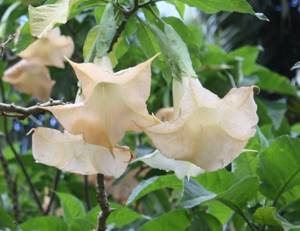
- Variegated or variegated (Brugmansia versicolor). Ecuador is considered its homeland. The height of the plant reaches 5 m. It forms large flowers up to 50 cm long. The shade of the tube is cream, and the corolla can be varied.
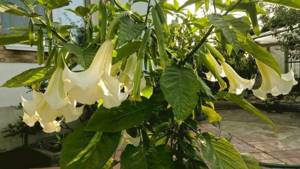
- Noticeable (Brugmansia Insignis). Grows in Ecuador. The height of Brugmansia reaches 4 m. The flowers are yellow, white and pink. There is waviness along the edge of the leaf plates.
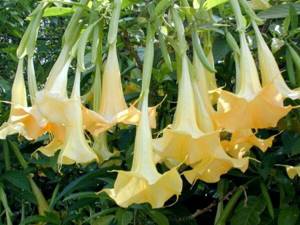
- Snow white (Brugmansia candida). It is a medium-sized tree with a short main trunk and a dense crown. It differs from other species in the thick pile on the leaf plates. The flowers are white with a strong aroma.
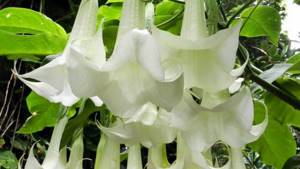
- Golden (Brugmansia aurea). The height of the plant does not exceed 4 m. It is characterized by a yellow tint of flowers, for which it received its name. The corolla of this species is curved, the stems are short.
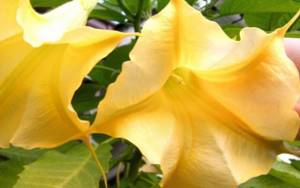
- Bloody (Brugmansia sanguinea). Characterized by a red tint to the corolla and a yellow trumpet. Grows in height no more than 4 m.
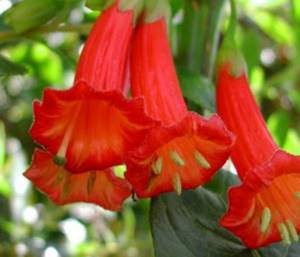
Comment! Bloody Brugmansia is one of the most cold-resistant species.
Application in landscape design
Brugmansia is widely used in landscape design. The plant looks best in single plantings against a green lawn. Experts also recommend planting it in the center of the flowerbed, and using low-growing flowering crops in the foreground.
This flower can be grown as a pot plant. In this case, the pot should be chosen to be heavy, since due to the windiness of the crown it may fall. Flowerpots with flowers are suitable for decorating terraces, loggias, as well as at the entrance to a gazebo or house.
Some flower growers, showing their imagination, plant several varieties of crops in one pot, and as they grow, the shoots are intertwined until they become lignified. This technique allows you to end up with a decorative tree with flowers of different shades.
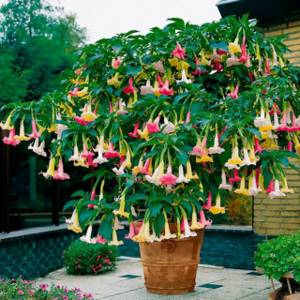
When planting several plants, the pot should be spacious and heavy enough
How does Brugmansia reproduce?
The crop can be propagated by cuttings and seeds. The first method is more preferable, since young seedlings completely retain the species qualities of the mother plant. When propagated by seed, they bloom for the first time only in 3-4 years.
Brugmansia should be rooted in the spring during the active growing season. To do this, it is necessary to cut the apical cuttings 15-20 cm long. The lower leaves must be removed, leaving only the top for sap flow. The cuttings should initially be placed in water and wait until they take root. This usually happens after 10-14 days. After this, plant them deep in the ground so that a full-fledged root system develops. You can plant Brugmansia seedlings in a permanent place when they are strong enough.
Important! Brugmagsia roots form throughout the shoot, which is located in the ground.
Propagation of Brugmansia by cuttings
Propagation by cuttings is the most reliable and common method of propagation. To do this, at the end of spring (beginning of summer), fresh shoots with an apical bud are taken and cut to a length of 20-25 cm (the lower leaves are removed).
Place in water, after adding activated carbon, spray the leaves so that they do not wither, cover with a plastic bottle or jar and put in a bright, warm (at least 20°C) place.
When the roots become about 5 cm, the cuttings can be safely transplanted into hills with a prepared substrate: peat, perlite, sand (2:1:1). After 2-3 weeks, rooting will occur and the plant can be transferred to a permanent pot.
Planting and caring for Brugmansia garden flowers
Planting must be carried out taking into account the basic requirements of the crop. To avoid problems in the future, you need to study them first.
When to plant Brugmansia in open ground
The plant should be planted in open ground when the air temperature warms up to +12-15 degrees, regardless of the time of day. Therefore, in the central regions, planting should be carried out at the end of May, and in the northern regions - at the beginning of June.
Important! If there is a threat of return frosts, the seedlings need to be covered, since if the temperature drops to +5 degrees, the plant may die.
Site selection and soil preparation
For Brugmansia, you need to choose open, well-lit areas, since with a lack of light, its shoots stretch and their decorative qualities decrease. It is important that the place is protected from drafts and strong gusts of wind.
This plant prefers nutritious soil, rich in organic matter with good air and moisture permeability. Therefore, the area for Brugmansia needs to be prepared in advance. It should be dug up and thoroughly cleaned of weed roots. After this, you need to prepare a planting hole measuring 60 by 60 cm. Fill it 2/3 of the volume with a special soil mixture of peat, humus, turf and sand, taken in equal quantities.
Important! The acidity level does not matter for Brugmansia.
Landing algorithm
The landing process is simple. Therefore, even any novice gardener can handle it.
Algorithm of actions:
- Water the planting hole generously.
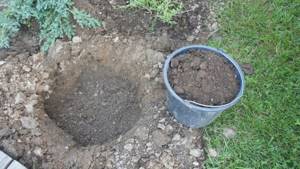
- Place the seedling in the center, deepening it by 15-20 cm.
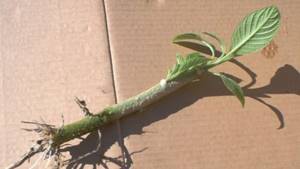
- Gently straighten the roots, sprinkle them with soil and fill all the resulting voids.
- Compact the surface at the base of the seedling.
- Water the plant again.
The next day, the root circle must be mulched with peat or humus, since at an early stage the plant is very sensitive to lack of moisture.
Home care
Fatsia flower: home care and methods of propagation
Brugmansia, which requires certain knowledge and skills to plant and care for, is a rather capricious plant. If you do not adhere to certain rules, most plant varieties will not tolerate the climatic conditions of Russia. It is grown in winter gardens, greenhouses, houses and apartments.
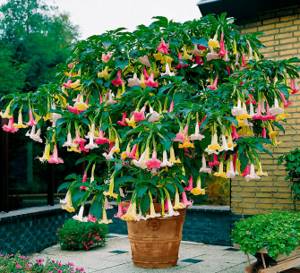
Brugmansia at home (in a portable container)
In open ground in northern latitudes, the shrub is extremely rare.
Temperature
All plant varieties love warmth. At a temperature of -5°C, the flower is first attacked by diseases and pests, then its immunity decreases, and then it dies completely. The most optimal temperature for the development of Brugmansia arborescens is considered to be 23°C.
Important! The shrub begins to bloom late - at the end of summer, when the night temperature drops to 13-15°C. Therefore, you can safely leave it on the balcony in early spring, after the end of frost, and until mid-autumn.
Watering
This is a moisture-loving plant. Caring for Brugmansia involves frequent watering. In winter, the number of waterings can be reduced to 2-3 per week. The amount of watering in winter depends on air humidity. A dangerous factor is drying out of the soil.
Location
Brugmansia does not tolerate drafts; care at home for this reason consists of locating it in a well-lit, warm place, with supports for the branches. The plant goes into a dormant state when there is little light.
The soil
Prefers oily, loamy soil.
Note! The acidity of the soil can be any. The most important thing is that the soil is nutritious. Since the plant develops quite quickly, nutrients can be added to the soil as fertilizer. Mineral fertilizers will be useful, as well as fertilizing with potassium and phosphorus.
Winter and spring
During the winter period, growing and caring for the Brugmansia plant is transferred to indoor conditions. The flower pot is placed in a cool place. The more illumination in the room, the less likely it is that Brugmansia is at rest. Some gardeners grow shrubs in winter, using phytolamps or additional artificial lighting. For Brugmansia to enter the growth phase, it is necessary to provide it with a temperature of at least 15°C and a daylight hours of 14-15 hours.
If the plant grows indoors, it is recommended to replant it every spring into a container 2 cm larger in diameter and height than the previous one. Since increased sap flow begins in spring, it is necessary to apply universal nutritional fertilizers to the soil once every 14 days. In spring, the amount of watering and spraying increases. Air humidity should be about 60%.
Pruning rules
Regular pruning of Brugmansia is necessary. Young shoots growing between the trunk and leaves must be trimmed. This will help to simultaneously decorate a bush or tree and provoke it to bloom. As a rule, pruning is carried out in mid-autumn, before Brugmansia is brought indoors for wintering.
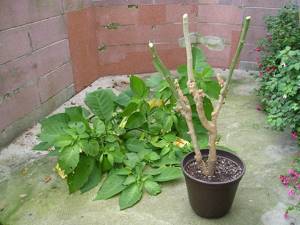
Brugmansia pruning
Growing Brugmansia in open ground
When growing crops in open ground, you must adhere to certain care rules. Otherwise, it may not please you with its flowering.
Watering schedule
During the active growing season, the plant needs regular watering, since if there is a lack of moisture in the soil, growth slows down. This causes the flowering period to shift significantly. For irrigation, you should use settled water at a temperature of +18 degrees. At least 20 liters of liquid should be poured under each plant.
Irrigation should be carried out 2 times a week, and in hot periods every other day. When watering, the soil should be wetted up to 20 cm.
Important! During the flowering period, Brugmansia needs to be watered less frequently.
How to feed Brugmansia
10 days after planting, Brugmansia needs to be fertilized with organic matter: mullein 1:10 and chicken manure 1:15. In the future, feeding should be carried out regularly at intervals of 2 weeks. Until mid-summer, you can use complex mineral mixtures with a high nitrogen content, and then with a high concentration of phosphorus and calcium.
Trimming
Since Brugmansia is a representative of the Solanaceae family, it, like its close relatives, is prone to growing stepchildren. Therefore, it is necessary to remove them several times during the season to redistribute the plant’s strength. This allows you to speed up the onset of flowering by several weeks.
Drastic pruning should be done before wintering. During this period, it is necessary to cut off all non-lignified shoots and reduce the number of leaves to a minimum.
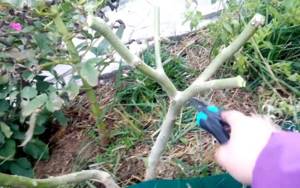
Before winter you need to cut off shoots as much as possible
How to preserve Brugmansia in winter
For successful wintering, the plant must be transplanted into a pot in the fall, keeping the earthen ball on the roots as much as possible. Then it needs to be moved to a cool, bright room. During this entire period, the plant should be watered moderately to prevent the roots from drying out.
You can also preserve Brugmansia in the basement in winter. To do this, you need to dig it up, wrap the lower part in film or a bucket, and water it a little. In the future, you need to moisten the soil once a month to prevent root rot from developing.
Important! The humidity level when storing Brugmansia in the basement should not exceed 70%.
We reveal the secrets of caring for Brugmansia
- VK
- Youtube
Do you look with admiration and envy at the Brugmansia blooming profusely in your neighbor’s garden? So, this tub plant blooms throughout the summer with a lush fountain of huge, slightly drooping tubular-bell-shaped flowers of divine shades, but in order to achieve such excellent flowering, you need to know and skillfully apply some very useful tricks.
Flower pots and soil
In a pot that is too small, Brugmansia suffers from drying out soil, as its drooping leaves will tell you. Young plants should be replanted every spring into a new pot with a diameter 2-3 cm larger than the previous one. For this tree-like shrub, which is also called angel trumpets, plastic pots are best suited rather than clay or terracotta: because the root system in them grows more evenly, and thin roots do not grow to the walls. It is very important to make drainage holes in the bottom of the container through which excess water escapes.
The large leaves of Brugmansia evaporate a lot of moisture, and when there are gusts of wind, they lose their balance and can easily break off. Therefore, it is worth choosing a large enough tub for the plant that can hold more water and be quite stable. Large stone tubs are highly prized. On the bottom, in which holes are made to drain excess water, pour a layer of expanded clay. When growing Brugmansia, use regular soil for tub plants. The further development of the plant is very favorably affected by the addition of some clay granules to the soil, which conserves moisture and nutrients. If in doubt, enrich the substrate with clay granules or expanded clay at the rate of 10% of its total volume.
Brugmansia 'Feuerwerk' (Brugmansia sanguinea) in a tub made of plastic imitating the texture of stone casting
Tip: in summer Brugmansia should be planted directly in open ground in the garden. This way, your flowering shrub will be more evenly supplied with water. However, before the first frost, the cold-sensitive plant must be carefully dug up and planted in a tub, placing it in a place protected from frost for the winter. Digging up the roots every year does not harm the plant.
Ideal location
In spring, Brugmansia should be left in a slightly shady place for some time (3-4 days) so that it can get used to intense sunlight. Our angel trumpets will then be able to withstand even direct sunlight. A sheltered from the wind, very bright, but shaded from the midday sun place in the garden or on the terrace is ideal. Diffused shade for the plant is created, for example, by tree crowns or lace umbrellas.
Abundant watering
Brugmansia, with its large, oval-elongated, slightly pubescent leaves, consumes an extremely large amount of water. Therefore, in summer it is necessary to water the plant at least once, and on hot days - even twice a day. Water until excess water comes out of the drainage holes and into the pan.

Fragrant Brugmansia 'Frosty Pink' (Brugmansia suaveolens). In nature in its homeland, in southeastern Brazil, it reaches up to 5 m in height
Generous feeding
Brugmansia, like almost all members of the nightshade family (Solanaceae, which includes, for example, tomatoes and tobacco) is a strong consumer of nutrients. And the key to their long and abundant flowering is regular and generous feeding. Therefore, already in the spring, during replanting, long-acting fertilizer should be mixed into fresh soil for balcony or tub plants. In addition, from May to August, feed your beauty once or twice a week with liquid fertilizer for flowering plants, adding it to the water for watering. And you can be completely calm, in the case of Brugmansia, oversaturation with fertilizers is almost impossible! The experience of many amateur gardeners shows that good results can be achieved with the help of conventional mineral fertilizer, for example Blaukorn. Dissolve two heaped tablespoons in 10 liters of water for irrigation. At the end of August, all feeding should be stopped, which will stop the growth of the plant and contribute to the lignification of the shoots.

Garden bench framed by abundantly flowering Brugmansia bushes
Pruning: pay attention to the shape of the leaves
During the period when Brugmansia is in the open air, it, in principle, does not need pruning, since the plant branches well and forms a sufficient number of flower shoots. In the winter apartment, our angel trumpets, due to lack of light, send out mostly thin, few-branched shoots with small, pale green leaves. Such shoots should be shortened in the spring, leaving only 1-2 asymmetrical leaves. The plant produces flowers above Y-shaped branches called “forks.” The flowering zone can be determined by the base of the leaf: a symmetrical leaf indicates the growing zone, and a ledge at the base of the leaf indicates the beginning of the flowering zone. In the fall, Brugmansia is pruned so that it does not take up too much space in the winter apartment. Attention: trim the plant so that at least one asymmetrical leaf remains on one flower shoot. Trimming shoots to leave only symmetrical leaves will delay flowering next season.
Advice: after pruning, in the fall, do not immediately transfer the plant indoors for wintering. Leave the cut brugmansia for several days on a warm terrace to allow the fresh cuts to dry.

The flowering areas of the shoots have asymmetrical leaves (leaf on the left). In the zone with symmetrical leaves, that is, leaves of the correct shape (leaf on the right), flowers do not form. When pruning a plant, you should not leave only symmetrical leaves.
Common diseases and pests
Brugmansia is almost not susceptible to diseases, but can be affected by various pests, for example, weevils. Beetles can be very easily recognized by their characteristic, semicircular, eaten away areas along the edges of the foliage. Snails also love to eat soft, fleshy leaves. In addition, Brugmansia is often affected by spider mites. As a rule, plants that are kept in poorly ventilated areas all year round suffer from it.
Wintering
Brugmansia is left to overwinter in a bright, cool (about 10-15°C) room. This could be a winter garden. In such conditions, the plant completely retains its leaves and continues to bloom for some time - which is not given to everyone due to flowers that have an intense aroma. Some gardeners place Brugmansia in a dark place for the winter. In any case, the air temperature should be, if possible, stable around 5° C. In such conditions, the plant sheds almost all its leaves, but recovers very quickly in the spring. In a dark, cold room, brugmansia is watered so that the roots do not dry out. If the plant overwinters in a bright room, then it should be watered more and checked for pest damage more often.

Several amazing Brugmansia varieties from the private garden of Monika Gottschalk, Germany
| Abundantly blooming Brugmansia (Brugmansia x cubensi)s 'Edna' with bell-shaped, drooping, double flowers of medium size (27 - 29cm), painted in a delicate white-pink color. | The charming Brugmansia (Brugmansia x cubensis) 'Fandango' amazes with its bell-shaped, white flowers with a peachy bloom. To prolong abundant flowering, Brugancia should be in partial shade in a place protected from the winds. |
| Brugmansia x candida 'Marie Stöppler' with large (30 – 33 cm), drooping, double bell-shaped flowers of soft pink color. | Snow-white Brugmansia "Brugmansia x candida" 'Diebsteinperle' with double, drooping bells (30 - 33cm) of a peculiar shape. Abundantly flowering hybrid. |

Large (30 – 33cm), very beautiful drooping flowers with a wide corolla of Brugmansia x candida 'Luise'. The color of the flowers is cream with an apricot bloom.
Translation: Lesya Vasko especially for the gardening internet portal
Publication date: July 22, 2010
comments
Lesya Vasko
If you notice an error, select the required text and press Ctrl+Enter to report it to the editors
Comments:
There are no comments yet, you can add your own comment. For this you need to register or log in.
Authorization
You have entered an incorrect login/password
adding a comment
Useful articles
- Polycarbonate greenhouse
Brugmansia pests and diseases
This plant has high natural immunity, but if the growing conditions are inappropriate, it decreases. In this case, Brugmansia becomes susceptible to pests and diseases.
Possible problems:
- Spider mite. This harmful insect is difficult to see with the naked eye. The lesion can be recognized only by the presence of small yellow dots along the edge of the plates and a thin cobweb on the top of young shoots. To fight, you need to use Actellik.

- Aphid. A sucking pest that feeds on plant sap. It forms entire colonies that can be seen on the shoots and on the back of the leaves. For destruction it is recommended to use Inta-Vir.

- Slugs. These pests are nocturnal and feed on young foliage. The provoking factor for their reproduction is high humidity. To repel slugs, it is recommended to sprinkle the soil at the base of the plant with wood ash and tobacco dust.
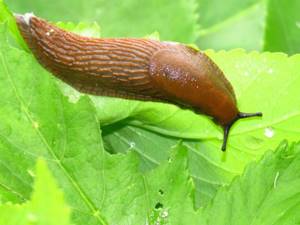
- Brown rot. The disease develops in cool, humid summers. It is characterized by a gray coating on the leaves that interferes with photosynthesis. Subsequently, the affected areas increase in size and completely extend to the entire plate. This leads to premature leaf fall. For treatment it is necessary to use fungicides.
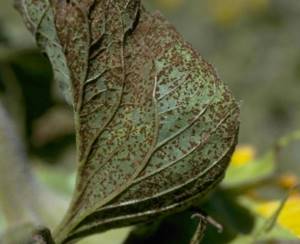
Possible problems when growing Brugmansia
You can often hear from gardeners that Brugmansia sheds its leaves, does not bloom, or its plates have turned yellow. All this suggests that the plant does not receive sufficient care for full development. Therefore, you should study when a flower needs help, what to do in each specific case.
Why do Brugmansia leaves turn yellow?
This problem is the most common. Yellowing of Brugmansia foliage may be due to a lack of nitrogen during the period of active growth, adaptation to a new location, as well as a lack of moisture. In this case, it is necessary to adjust the conditions for caring for the plant.
Why do Brugmansia leaves curl?
This problem occurs when Brugmansia is infected by spider mites. The pest makes punctures along the edge of the leaf plates, which leads to disruption of metabolic processes in this part of the leaf. For treatment it is necessary to use Actellik.
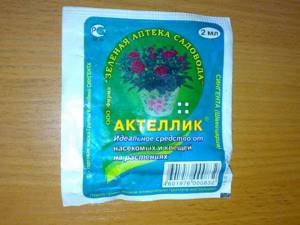
Use the solution immediately after preparation
Why do Brugmansia leaves fall off?
This problem occurs most often when growing the crop as a tub plant. During growth, the soil in the pot becomes compacted, which impairs air access to the roots. This leads to the death of the suction shoots, and, as a consequence, to the fall of the foliage. To improve the situation, it is necessary to transplant into a larger container. Otherwise, planting and caring for Brugmansia in a pot is carried out in the same way as in open ground.
Important! The falling of the lower leaves of a plant can be caused by a natural process, since it belongs to tree-like crops.
Why do Brugmansia branches dry out?
This problem occurs when the function of the root system is impaired, resulting in food not reaching the upper part of the plant. This is often caused by overfilling. In this case, Brugmansia can be saved only at the initial stage. To do this, you need to water the plant with Previkur Energy working solution.
Why doesn't Brugmansia bloom?
Lack of flowering may be due to the age of the plant. Seedlings obtained from seeds begin to form buds only after 3-4 years, until they become sufficiently strong.
In other cases, Brugmansia may not bloom if there is a deficiency of phosphorus and potassium in the soil, as well as with a lack of light.
How to make Brugmansia bloom
To make the plant bloom, it is necessary to remove all excess shoots. And then fertilize with superphosphate (30 g) and potassium sulfide (20 g) in a bucket of water. The plant needs to be fertilized 2-3 times every 10 days.
Fertilizer
The plant needs to be fertilized only during the period of growth and flowering in spring and summer. Complex mineral fertilizers for deciduous plants are suitable for feeding before flowering. Feeding is carried out 2 times a month, starting in April.
After the buds appear, Brugmansia is fed with fertilizers for flowering plants. They are introduced into moist soil a few hours after watering.
After Brugmansia finishes flowering, feeding is gradually stopped.
It is recommended to feed Brugmansia with organic fertilizers 1-2 times a season.
Suitable for this purpose: diluted chicken manure, mullein, or purchased organic fertilizers for indoor and garden plants.

